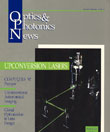
March 1992 Issue
Feature Articles
Unconventional Astronomical Imaging
Unconventional imaging techniques have been studied to improve the ability to obtain high resolution images of distant objects viewed through a random medium such as the atmosphere. In this paper, the term "conventional imaging" refers to the common case of opening the shutter of a large telescope, collecting photons on film or an electronic detection device, and accepting the result as the final product of the measurement process. Unconventional imaging is distinguished from this definition by three key characteristics: (1) the need to obtain the highest possible resolution in the final image, (2) the use of clever measurement techniques, and (3) the use of post-detection image processing to reconstruct a high quality image from the measurements.
by Michael C. Roggemann and David W. TylerGlobal Optimization In Lens Design
The goal of any design task is to find the best system. For most problems, however, it is generally infeasible to guarantee that the globally best system has been located. The traditional fall-back position has been to find a system that is locally best—that is, small changes in the resulting design are assuredly detrimental. Unfortunately, most locally-optimal systems are inadequate so the designer is put upon to provide an appropriate, rough configuration that is then incrementally modified until a locally-best (hopefully adequate) form is found. Local optimization algorithms carry out this task and typically proceed by monitoring derivatives to advance to a local extremum. This is straightforward: it is as simple as rolling down a hillside until there's no more rolling to be had. The quality of the final form, however, is critically dependent on the start point and it is evident that conventional computer-aided design serves primarily but to polish the designer's original system.
by Greg Forbes and Andrew JonesFluorescence And The Color Of Day Glo Paints
To the casual observer, a white piece of paper seems white whether viewed at dawn, noon, or dusk. In contrast, fine arts painters must compare the colors of their paint mixtures to the scene they are viewing. They recognize that the actual color of an object depends as much on the color of the light used for illumination as it does on the nature of the object. The effect is most obvious with objects that appear white or yellow in sunlight and some of the new "Day Glo" colors (especially the "Saturn" and "Arc" yellows).
by Susan Houde-WalterVector Diffraction Theory Of Focusing In Systems Of High Numerical Aperture
The diffraction image formed by a perfect lens is well known as the "Airy Disc". Many engineers may not realize that this familiar concept requires modification when large numerical apertures and polarization are involved. The following technical note indicates some of the effects for an extreme F/0.52 imaging situation, as might be found in an optical data storage system. This article also discusses some of the techniques needed for computing diffraction effects in such extreme, but more frequently occurring, conditions.
by Masud MansuripurMissing The Mark On Standards Could Mean Missing The Market
For some time now we have been writing about the progress being made in writing international standards related to optics and optical instruments. The standards that have been written to date deal with definitions, methods of describing optical elements in drawings, and procedures for doing tests. These initial standards serve as the foundation for standards yet to come, but do not have an immediate impact on the way business is done in the optics community.
by Robert E. ParksUpconversion Lasers
Upconversion lasers represent a class of optically-pumped lasers that oscillate at frequencies higher than those used for pumping. Using nonlinear excitation processes, these lasers can convert infrared pump radiation from III-V semiconductor diode lasers, for example, to visible laser output. Thus upconversion pumping is an alternative to using parametric nonlinear optical processes such as frequency doubling for converting infrared laser radiation to coherent, short-wavelength output. The operation of a number of such upconversion lasers has been demonstrated in recent years using rare-earth ions doped into crystals and glasses as the laser medium. Upconversion lasers can potentially provide practical all-solid state sources with output at wavelengths from the ultraviolet to the red for a wide range of applications, including color displays, optical data storage, biomedical diagnostics, and underwater optical communication.
by Wilfried Lenth and Roger M. MacFarlane
![Illustration of optical skyrmions. [Y. Shen]](https://opnmedia.blob.core.windows.net/$web/opn/media/images/articles/2025/0525/departments/202505-cover-web.jpg?ext=.jpg)
![Illustration of a synapse in the brain. [Getty Images]](https://opnmedia.blob.core.windows.net/$web/opn/media/images/articles/2025/0425/departments/202504-cover-web.jpg?ext=.jpg)
![Fiber draped around a hand, demonstrating its flexibility. [Photo by Z. Wang and L. Wei]](https://opnmedia.blob.core.windows.net/$web/opn/media/images/articles/2025/0325/departments/202503-cover-web.jpg?ext=.jpg)